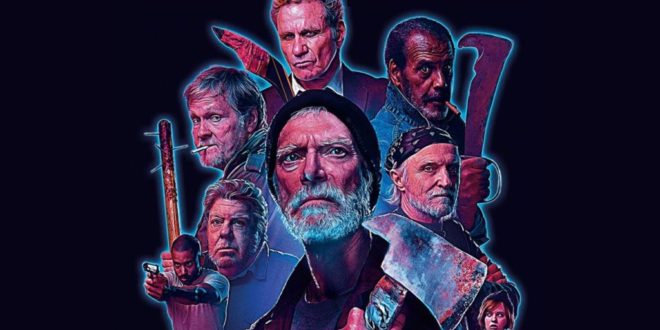It’s easy to watch a genre film these days and point out “that’s been done before.” The fact is, nearly everything has been done before in some capacity. All stories are derivative of something, but some more than others. VFW, the latest film from director Joe Begos, unfortunately, crosses the point of no return—that place in which homage transforms into regurgitation, with little to offer that hasn’t already been done, in a style that’s neither new or fresh. It’s not a particularly bad film, and even contains some good elements—but overall it feels all-to-familiar to the point of inducing apathy, and that is perhaps even worse than being a bad movie. With an all-star cast and a tried-and-true concept, the film had a lot of potential to be interesting but overall left a lot to be desired.
VFW takes place in a reality in which the opioid crisis has reached a breaking point. A new drug called Hype is all the rage, figuratively and literally. The substance transforms its users into rabid junkies, craving their next fix and willing to do anything necessary to get it. At the start of the film, we’re introduced to the key members of a ruthless street gang, primarily responsible for pushing the drug. After a young woman steals a sizable stash of Hype, she’s chased by the entire gang through the streets. The chase ends at a local VFW club (Veterans of Foreign Wars), where a group of aging vets are celebrating their friend’s birthday. All hell breaks loose when the girl tries to hide inside the club, and the gang members follow. As the army of zombified junkies descends upon the club, the vets must use their experience and combat training to survive the night. What follows is a blood bath of gore, brains, bone-crunching, and all manner of things that squish.

If this story seems familiar, that’s because it’s basically John Carpenter’s Assault on Precinct 13. Of course, Carpenter would be the first to admit that his film was in fact derivative of Rio Bravo, but there remains one large distinction that separates Assault on Precinct 13 from VFW: execution. Carpenter took the story of Rio Bravo and stylistically mutated it into something that felt original, whereas VFW is very much a team of filmmakers taking a story, and executing it roughly in the same exact style it was originally done in. Therein rests VFW‘s biggest problem—it feels like something we’ve seen before. This is a horror film made by people who have seen too many horror films. We get it—Carpenter was a big influence on Begos, but I never feel like I’m getting a sense of this filmmaker’s voice or unique identity. Anyone can watch something and mimic it—the real challenge comes when you want to pay homage to a particular style, while still retaining your own singular personality. Begos fails to do that here, and the film suffers greatly for it. The cinematography aspires to be colorful and throwback, but instead, the film largely feels as if it were shot in a laser tag arena. The colors often feel misused or out of place, and at times scenes are lit too dark to be able to visually interpret the blocking.

While the film does boast some good performances from the likes of Stephen Lang (Don’t Breathe 2016), other actors in the film feel miscast—in particular, the lead gang members. The actors playing the gritty and hardened street criminals look more like underwear models than they do drug pushers. What should be the most intense element of the film isn’t actually all that intense, and at no point did I ever feel particularly threatened by any of the gang characters. Nor did I feel too attached to any of the vets either. There’s too many of them to be able to form a deep bond with the characters, and we’re never really given a reason to care about their well-being beyond the fact that they’re old men. We get a few stereotypical war stories, but other than that there isn’t a lot of depth to these men. Somewhere in this movie, there’s an intelligent genre film with a lot to say about veterans and the way in which they are treated by society, but VFW never quite gets that smart. Instead, it goes for the throat with blood and violence, which is maybe the only thing in this movie I genuinely enjoyed. The makeup and gore effects in this film are without question the highlight. For such a low budget film, the gore is satisfying and looks great on screen, and the action sequences are undeniably thrilling. Begos has an eye for chaos, and it’s clear he’s most in his element when he’s conducting mayhem. While I applaud the brutality of the film, violence alone is not style or substance, and a film can’t merely prop itself upon its own vulgarity.
At the end of the day, I’m massively disappointed. I expected more from VFW and so badly wanted to enjoy it, but couldn’t help but feel completely apathetic. As I mentioned before, VFW is far from the worst film I’ve ever seen—it’s competently made, it looks and sounds better than most low budget horror films do. But VFW is average, and I could not find the energy to care about any of its characters. I was expecting more striking visuals, a more unique take on the retro, 80s-horror-craze that’s been devouring the genre lately—but I found yet another hollow fan film. I’ve been told Begos is an exciting director in today’s horror scene and having not seen any of his other films maybe I should go look at those for a better idea of what he’s all about. But VFW was not for me.
VFW hits Theaters, On-Demand, and Digital HD on February 14, 2020. Check it out and let us know what you think!
 PopHorror Let's Get Scared
PopHorror Let's Get Scared




